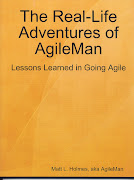Occasional blogger Ron in L.A. posted an entry recently about bad experiences in the stock market. While I've certainly had my share of those, too - including during some dubious movements of my former company's stock price - I've had pretty good luck of late in terms of gains versus losses.
The vast majority of the savings Vicki and I have, both RSP and non-RSP, is managed by professionals, is diversified, and gets returns that are by-and-large in line with the general market. So the last few years have been healthy, while the several years before that we were getting neglible return on our money, if that.
On the other hand, we also have a little "mad money" that Vicki was happy to have me self-direct, just to see what I could do with it. This cache amounts to less than 5% of our total savings, so it's not exactly a high risk venture. In other words, if I lost it all, I'd be mad at myself, but the impact to our financial future would be almost nil (we might have to work a few extra months before retiring). Over the last four or five years, I've developed - or learned - a bit of a system that I use, which has proven to be somewhat successful. My goal is always to make at least 8% return, each year, since in capital gains terms that's a nice 6% growth rate after taxes, and it would match the average of what we've gotten from the professionals. And so far I've exceeded that goal every year, sometimes by nearly double.
My strategy begins with picking out a few companies that I know something about, whether through the news or because a friend worked there once, or whatever. I make sure they've got a product that seems like it should be popular, as I want to avoid investing in any company that's just a flash in the pan. An example of this, which I don't actually use, would be Microsoft. I know someone who worked there before, they've clearly got a market (or two) cornered, and their product is wildly popular (albeit widely scorned, ironically). Two of the reasons I don't trade Microsoft stock are the fact that I'm not crazy about their cut-throat business model, and their stock doesn't always move all that much. The first reason is just personal preference; the second affects my strategy.
What I'm looking for are companies that tend to move up and down a lot, but aren't really volatile. Generally, they need to have a median stock price that sometimes they're 10-20% up from, or 10-20% down from, but they're unlikely to double in price or lose 80% of their value anytime soon. What I want to do is buy their stock when it's in the low end of that cycle, and sell it when it's in the high end. But since guessing the peaks and troughs is clearly impossible (despite what millions of people seem to think), all I'm really trying to do is get close enough to those high and low points to pick up a 5% return or more. Since that often can be done several times per year, per stock, it's not all that hard to accumulate high single-digit or even low double-digit returns over the course of a year.
My observation has been that most people won't settle for a 5% return, since they reason that if they can get 5%, why not hold out for 10%? And sometimes even when they could pocket that 10% return, they'll get greedy and wait for a chance to get 20%! The way that story usually ends is: they get nothing or even lose money, in the end. Personally, I'm happy to invest in a company for several months in order to get a tidy little 5% capital gain. I figure they're using my money to better themselves in some way, and once that's reflected in the stock price, I cash out and take my payment. (I know it doesn't really work that way, but I can dream.)
One of the tricks to making this work is paying low transaction fees, since it's hard to even get a 5% return if you're paying 2 - 5% of your investment in transaction fees. I use E*Trade for this, because I can generally make the buy and sell transaction fees add up to less than 1%, meaning that I really need the stock price to go up around 6%. Again, not hard to do, if you're willing to sell once you can get 6% and not hold out for more. Occasionally, a stock will go up a lot in one day, such that by the time I notice and put in a Sell order, I'm actually making 10% or more. Those are obviously bonus situations that I don't count on, but I usually get at least a couple of them each year.
And of course I run the risk, every day, that the bottom could fall out of any or all of those stocks, leaving me with not only no returns, but no starting money either! Fortunately, I'm almost at the point where I've doubled my original money. Since I take my "winnings" periodically rather than re-investing them, I'll soon be at the point where the worst I could do, over the long haul, is have broken even (0% return over several years) which clearly wouldn't be good. But on the other hand, it means I really will be playing with money I can afford to lose!
Disclaimer: I don't advocate this approach for anyone else! I get away with it because I'm not counting on this money, and anyone who'd gamble like this, with cash they actually need for other purposes, is a fool!
Saturday, March 03, 2007
Subscribe to:
Post Comments (Atom)















No comments:
Post a Comment